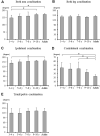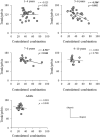Development of the Relationships Among Dynamic Balance Control, Inter-limb Coordination, and Torso Coordination During Gait in Children Aged 3-10 Years
- PMID: 34776908
- PMCID: PMC8582286
- DOI: 10.3389/fnhum.2021.740509
Development of the Relationships Among Dynamic Balance Control, Inter-limb Coordination, and Torso Coordination During Gait in Children Aged 3-10 Years
Abstract
Knowledge about the developmental process of dynamic balance control comprised of upper arms and upper legs coordination and trunk and pelvis twist coordination is important to advance effective balance assessment for abnormal development. However, the mechanisms of these coordination and stability control during gait in childhood are unknown.This study examined the development of dynamic postural stability, upper arm and upper leg coordination, and trunk and pelvic twist coordination during gait, and investigated the potential mechanisms integrating the central nervous system with inter-limb coordination and trunk and pelvic twist coordination to control extrapolated center of the body mass (XCOM). This study included 77 healthy children aged 3-10 years and 15 young adults. The child cohort was divided into four groups by age: 3-4, 5-6, 7-8, and 9-10 years. Participants walked barefoot at a self-selected walking speed along an 8 m walkway. A three-dimensional motion capture system was used for calculating the XCOM, the spatial margin of stability (MoS), and phase coupling movements of the upper arms, upper legs, trunk, and pelvic segments. MoS in the mediolateral axis was significantly higher in the young adults than in all children groups. Contralateral coordination (ipsilateral upper arm and contralateral upper leg combination) gradually changed to an in-phase pattern with increasing age until age 9 years. Significant correlations of XCOMML with contralateral coordination and with trunk and pelvic twist coordination (trunk/pelvis coordination) were found. Significant correlations between contralateral coordination and trunk/pelvis coordination were observed only in the 5-6 years and at 7-8 years groups.Dynamic postural stability during gait was not fully mature at age 10. XCOM control is associated with the development of contralateral coordination and trunk and pelvic twist coordination. The closer to in-phase pattern of contralateral upper limb coordination improved the XCOM fluctuations. Conversely, the out-of-phase pattern (about 90 degrees) of the trunk/pelvis coordination increased theXCOM fluctuation. Additionally, a different control strategy was used among children 3-8 years of age and individuals over 9 years of age, which suggests that 3-4-year-old children showed a disorderly coordination strategy between limb swing and torso movement, and in children 5-8 years of age, limb swing depended on trunk/pelvis coordination.
Keywords: balance control; dynamic postural stability; gait; inter-limb coordination; motor development; trunk coordination.
Copyright © 2021 Mani, Miyagishima, Kozuka, Inoue, Hasegawa and Asaka.
Conflict of interest statement
The authors declare that the research was conducted in the absence of any commercial or financial relationships that could be construed as a potential conflict of interest.
Figures








Similar articles
-
Narrow-based gait in people with Parkinson's disease: Its mechanisms explored.J Parkinsons Dis. 2025 Mar;15(2):329-337. doi: 10.1177/1877718X241313333. Epub 2025 Feb 2. J Parkinsons Dis. 2025. PMID: 39973508
-
The effect of walking with reduced trunk motion on dynamic stability in healthy adults.Gait Posture. 2023 Jun;103:113-118. doi: 10.1016/j.gaitpost.2023.05.004. Epub 2023 May 5. Gait Posture. 2023. PMID: 37156163
-
Age-related differences in interlimb coordination during typical gait: An observational study.Gait Posture. 2020 Sep;81:109-115. doi: 10.1016/j.gaitpost.2020.07.013. Epub 2020 Jul 17. Gait Posture. 2020. PMID: 32707402
-
Contributions to the understanding of gait control.Dan Med J. 2014 Apr;61(4):B4823. Dan Med J. 2014. PMID: 24814597 Review.
-
Coordination of the upper and lower extremities during walking in children with cerebral palsy.Gait Posture. 2021 May;86:251-255. doi: 10.1016/j.gaitpost.2021.03.028. Epub 2021 Mar 24. Gait Posture. 2021. PMID: 33812293 Review.
References
LinkOut - more resources
Full Text Sources

